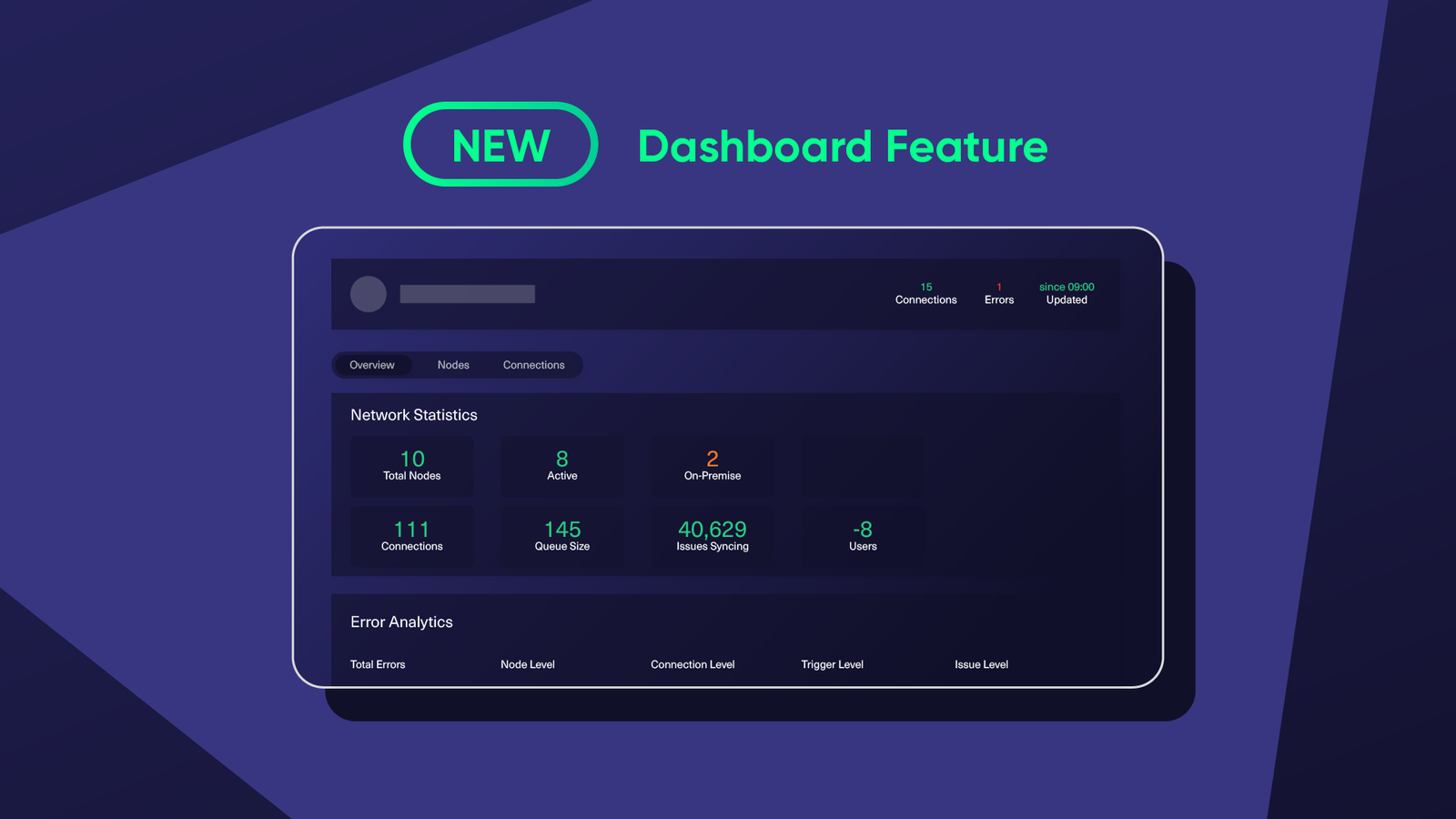The only way to extend ServiceNow for your ITSM is through integration.
Although this is possible with IntegrationHub and other native integrations, these solutions give you limited flexibility and customization options.
With a ServiceNow third-party integration tool, you can explore multiple use cases for connecting with other platforms, applications, databases, and more.
But all third-party integration solutions come with unique features and challenges, which you must account for before choosing one for your organization.
So, let’s explore everything worth knowing about ServiceNow third-party integration.
What are ServiceNow Integration Tools?
ServiceNow integration tools are applications or scripts that allow users to connect ServiceNow with third-party platforms (e.g., cloud services, SaaS applications, and databases).
These tools provide an interactive environment for applications that are not compatible with ServiceNow to fetch data from their native APIs and send it to ServiceNow.
Types of ServiceNow Integration Tools
Tools for connecting ServiceNow with other systems are either ServiceNow-developed or available through third parties. These tools usually fall within these categories:
Native (IntegrationHub)
IntegrationHub is a platform provided by ServiceNow to facilitate connections with third-party systems. It enables the execution of third-party APIs as a part of a flow when a specific event occurs in ServiceNow.
IntegrationHub also relies on spokes, which control the connection without the need to write a script. Installing any of the packages allows users to configure spokes for other platforms using the built-in Flow Designer.
For instance, if you want a ServiceNow connector for Jira, use bi-directional webhooks and subscribe to Jira with a ServiceNow callback URL. This will activate the Jira Spoke and assist with API calls.
Third-Party Tools
As mentioned earlier, third-party tools help ServiceNow to interact with other systems by bridging the formatting and interoperability gap.
ServiceNow third-party data integration lets you display retrieved data in Agent Workspace for CSM without storing it in your ServiceNow instance.
For this to work, you’d need the following:
- Remote Table definitions and tags
- OAuth 2.0 – JWT Bearer grant type
- Customer service.
These third-party integrations in the ServiceNow environment can also function as either iPaaS or custom ETL solutions.
iPaaS
ServiceNow iPaaS solutions provide a suite of tools that go beyond simply getting two incompatible platforms to share data.
These solutions combine no-code configuration with code-based algorithms and triggers to control how the configuration works.
Also, embedded iPaaS systems for ServiceNow take things a step further by providing AI-powered engines and other forms of automation for scripting connections.
The services of support engineers will be at your disposal whenever the solution malfunctions.
Custom-built Solutions
Even with the multitude of options available for ServiceNow data integration, companies with massive R&D departments usually opt for custom scripts to set up connections.
Of course, this involves an expert team of developers who thoroughly understand the API architecture and the programming language needed to work with it.
This also brings about the challenge of maintenance and upgrades to keep the custom code up to par.
So when you do the math, it becomes evident that an enterprise ServiceNow third-party solution is usually the best pound-for-pound value for your money.
Examples of ServiceNow Third-Party Integration Tools
Here are some iPaaS solutions that support the integration of ServiceNow with third-party apps.
Exalate
Exalate is an app that supports ServiceNow third-party integrations as well as connections between multiple ServiceNow instances. It provides a simple Basic mode and an AI-enabled Script mode for making custom connections.

Let’s say you want to sync a ServiceNow instance with Jira. Exalate allows you to sync entities such as incidents, CMDBs, change requests, problems, and much more.
To obtain any other information related to Exalate, you can always ask Aida, the AI-enabled documentation assistant.
Exalate offers a free plan that allows you to sync up to 1,000 new issues per month. It also offers a 30-day trial for any connector.
MuleSoft
Mulesoft is the premium iPaaS connector within the Salesforce ecosystem. That’s why it is a safe bet for ServiceNow to Salesforce integration. This solution supports both default and custom connections.
Specifically, the Anypoint ServiceNow Connector integrates seamlessly with multiple other CRMs, SaaS applications, and cloud services.
Mulesoft is not limited to integrations between ServiceNow and Salesforce. You can also connect other systems bidirectionally to guarantee accuracy and timely exchanges.
Dell Boomi
Boomi is an iPaaS platform that combines the power of AI and automation to enable the synchronization of systems.
Boomi AI Studio allows users to automate workflows with low code, design event streams, and establish a foundation for trusted data.
In conjunction with ServiceNow, Boomi has developed a solution called Workflow Data Fabric, which is an automation engine for keeping track of syncs between ServiceNow and other systems.
Zapier
Zapier is an automated integration tool that allows you to connect ServiceNow with multiple other platforms. It has an extensive library of Zaps—automated connections and workflows—that enable data exchange between applications and services.

Even with advanced features such as filters and webhooks, Zapier is limited in its applicability because it doesn’t support fully custom connections and works mostly for “fire and forget” kind of use cases. You are limited to the default options.
Workato
Workato is an enterprise iPaaS solution that provides an integration and automation platform for connecting multiple applications.
Apart from basic integration, Workato also has a Data Hub as well as Workflow Bots for automating workflows and processes.
Workato Recipes also include actions and triggers that follow predefined conditions. These control how the connection works and how data flows between the two connected applications.
What Should a ServiceNow Third-Party Integration Tool Have?
Here are some must-have features for any reliable ServiceNow third-party integration tool:
- Airtight Security: ServiceNow integrations should be able to protect sensitive data as it moves between platforms. This involves the inclusion of security features such as tokenization, encryption, pseudonymization, and role-based access controls. Other considerations include OAuth verification and multi-factor authentication (MFA).
- Multiple Connectors: The tool should support multiple connectors beyond just ServiceNow. This feature is valuable for multi-platform integrations, especially when different organizations or partners are involved.
- Ease of Use: Since ServiceNow will connect your IT team with other potentially non-technical users, look for a solution that requires little technical expertise to configure and set up. This will flatten the learning curve and improve the user experience across the board.
- Automation: Tools with automated event triggers and other forms of automation improve the productivity of teams with a synced ServiceNow instance. Apart from triggers, you can also automate alerts and notifications to enable real-time synchronization and speed up response times.
- Affordable Pricing: Make sure the cost of licensing and subscription does not exceed the stipulated budget. Some third-party solutions for ServiceNow integration only charge per user, which usually runs up the cost for enterprises with a lot of users.
- Reliable Support: When onboarding a ServiceNow integration tool, check out how they handle support and availability. This will make a huge difference when the sync malfunctions or the middleware solution unexpectedly goes offline.
As a general rule, always read independent reviews before committing to any integration service provider for ServiceNow and other platforms.
One integration tool that fits all these criteria is Exalate. It helps you achieve bi-directional sync across work management platforms, including Zendesk, Jira, ServiceNow, Salesforce, GitHub, Freshdesk, and others.
Why Do You Need ServiceNow Third-Party Integration?
The main reason to integrate ServiceNow with other systems is to enable the smooth flow of data between them. This can be a unidirectional or bidirectional integration.
For instance, LF Logistics uses Exalate to share updates between its help center and customer service department. The state of the ServiceNow incident was always instantly conveyed to the corresponding Jira issue.
Another reason to connect ServiceNow with third-party applications is to receive instant updates and data promptly.
Nviso, a cybersecurity MSSP, uses Exalate to share updates with partners, who mostly use ServiceNow. This is a valuable asset for companies facing constant cybersecurity threats.
Organizations like WirelessCar also deploy ServiceNow third-party integrations to streamline internal workflows and external collaborations with other brands.
Most importantly, third-party tools like Exalate shrink your SaaS sprawl and eliminate the need for context switching when collaborating with other teams or working with outsourcing partners.
Exalate: A Reliable ServiceNow Third-Party Integration
Here are the steps to follow to set up an integration between ServiceNow and any third-party application using Exalate.
Step 1: Install Exalate on ServiceNow and the Other Application
The first step is to install Exalate on ServiceNow and then on the other platforms (Jira, Azure DevOps, ServiceNow, Freshdesk, GitHub, Zendesk, Salesforce, etc).
You can request your Exalate for ServiceNow and other instances via the integrations page. Also, Exalate for ServiceNow can be installed on Docker.
Watch the full Exalate installation video for ServiceNow.
Step 2: Connect ServiceNow and the Other Application
First, set up a connection between ServiceNow and the other application. One side initiates the connection and generates an invitation code. The other side accepts the connection invitation using this invitation code.
It doesn’t matter which side starts initiating the connection; the Exalate UI remains the same.
Let’s start the connection from ServiceNow.
Navigate to the “Connections” screen in the Exalate console on the left-hand side menu bar.
Click on the “Initiate Connection” button.

Enter the “Destination Instance URL”. The destination instance URL is the URL of the application you need to sync with. I have considered Jira in this example. But it can be any other application Exalate supports.

The Basic mode allows you to set up simple connections for syncing basic ServiceNow fields and entities.
Let’s use the Script Mode.
Choose “Script” and click “Next”. Give a short name to the local instance and a short name to the remote instance.

Click “Next”.
An invitation code is generated. This needs to be copied and pasted into the destination instance. So click on “Copy invitation code”, then click “Done”.

On the destination instance, go to the Exalate console and select the “Connections” tab.
This time around, click the “Accept invitation” button.
Paste the code you have just copied.

Step 3: Configure the Connection to Decide What to Share
On the previous screen, if you click “Configure Sync,” you will be shown a panel that looks like this:

In the “Outgoing sync” on the ServiceNow side, write the code to control the destination of all values going to the other side. The destination instance accepts scripts for controlling “Incoming sync”.
Exalate’s Script mode features AI Assist, accessible via a chat window in both the incoming and outgoing sync rules tabs.
The scripts are created based on your input, current configurations, and Exalate’s scripting API and should appear shortly.
In the generated script, red lines show what will be removed, while green lines indicate new additions.

Like any AI tool, AI Assist isn’t perfect and can sometimes miss the mark. To achieve the best results, ensure your prompts are as clear and specific as possible.
Step 4: Start Automatic Synchronization Using Triggers
Once you have decided what information must be sent and received, you might want to start the synchronization process automatically based on certain events.
This is done via Triggers in Exalate. Based on the conditions (filters) you set, sync will happen in accordance with the Sync Rules.

You can write advanced triggers like syncing incidents assigned to a particular person or syncing incidents that have a particular text in a comment or description.
Need help connecting ServiceNow with any third-party app? Reach out to our engineers right away to get started.
Recommended Reads:
- ServiceNow to ServiceNow Integration: The Step-by-Step Guide to Setting up a Two-Way Sync
- ITSM Integration: Simplify Your IT Services Like Never Before
- ServiceNow Integrations: Integrate ServiceNow and Other Systems Bidirectionally
- Everything You Need to Know About ServiceNow Data Integration
- ServiceNow Connectors: How to Keep Systems and Companies Connected









